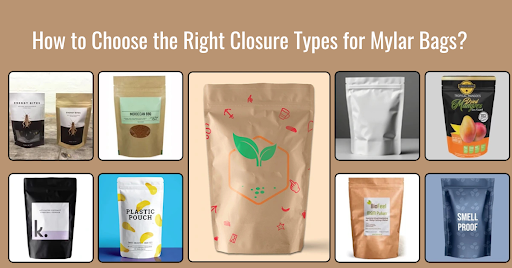
Closures are indispensable for Mylar bags. They are the opening gateway of Mylar packaging pouches. Strong and reliable closures keep the products fresh. They also protect them from moisture, contamination, and oxygen.
Similarly, Mylar bag closures improve the shelf life of the commodities. They are highly recommended for coffee, snacks, and vitamins. When customers open a bag and find products fully usable and aromatic, they feel happy. That simple moment builds lasting brand trust.
Safety is another key point. Many industries now utilize child-resistant closures that comply with FDA and ASTM standards. These closures stop children from opening dangerous products. Yet they stay easy for adults to use. This balance creates safety at home and strengthens confidence in the brand.
This blog highlights the basic types of closures, including the pros and cons of Mylar bag closures.
Factors to Consider When Choosing A Closure
There are several key considerations to keep in mind when choosing the proper closure for custom Mylar bags. I am listing them below.
Product Type: Different products need a variety of closures. Always look at them. For instance, food products need airtight closures. And when it comes to supplements, they require protection from moisture. This is how you can judge every product.
Shelf Life: Some products remain on the shelves for a longer period. While consumers buy other products earlier. Hence, a simple type of zipper is enough for snack bags. You can also use heat seals and strong closures for meat and pharmaceutical products.
Ease of Opening: I always suggest that my readers attach an easy-to-open closure to Mylar packaging bags. Indeed, manufacturers want the protection of their products until they are delivered to their customers. But if you bring a hard closure, it will make products difficult to open.
Pros And Cons of Different Types of Closures
The following are some of the prominent closure types.
- Zippers: These are simple and easy for customers. They work well for snacks and everyday items. However, these closures are for a limited use.
- Child-Resistant Closures: These types of closures help keep kids safe and comply with legal regulations. They are famous for their strong and reliable qualities. Their downside is a higher cost compared to regular closures.
- Heat Seal: This closure type offers strong protection and a clean finish. It is excellent for long-term storage. But it can be used only once, unless combined with a zipper.
- Tamper-Evident: Tamper-evident seals indicate if a bag has been opened. Product manufacturers attach them to build customers’ trust. However, these seals need extra steps during production.
- Press-to-Close: These types of closures are inexpensive and simple to use. These are perfectly fine for low-risk items. However, I recommend alternative closures for products that require tight security or substantial barriers.
What Closure Type is Better for Your Mylar Pouch?
Choosing the right closure depends on the product. Food items like coffee, snacks, and dry fruits need zippers. They keep products fresh and allow easy resealing. Supplements require child-resistant closures. These meet safety laws and protect children from easy access.
Similarly, pharmaceuticals often use tamper-evident seals combined with heat seals for added security. Cost is another factor. Some closures, like child-resistant sliders, are more expensive. But they bring compliance and safety that businesses cannot ignore.
Affordable options, such as press-to-close zippers, work well for low-risk products. Balancing cost, safety, and customer convenience enables brands to select closures that align with their market position. Industries show clear patterns in closure choice.
Every Product Needs A Distinctive Type of Closure
Each product has its own needs. A snack bag may only need a zipper for freshness. A sensitive product pouch must include child-resistant features. Pharma packaging often combines tamper-evident seals with heat seals. The choice changes with the product.
The right closure depends on more than sealing strength. Safety is critical for regulated products. Freshness matters for foods and protein powders. Compliance keeps businesses within the law. At the same time, consumers expect convenience. A closure should protect the product and still feel simple to use.
Brands should not be afraid to test different closures. In some cases, combining options gives the best results. A zipper, combined with a heat seal, offers both resealability and long-term protection. Testing helps strike a balance between safety, cost, and usability. That process leads to customers’ trust.
Key Takeaways
- Closures give buyers confidence when goods are opened in perfect condition.
- Child-safe closures protect kids and meet U.S. safety rules.
- Picking the right closure depends on shelf life and product type.
- Heat seals give strong protection but are one-time use.
- Tamper seals show if a bag was opened before.
- Press zippers are cheap and quick but less secure.
- Foods like coffee, nuts, and cereals often use zippers.
- Vitamins and medicines need child-safe or tamper locks.
- Pharma bags mix heat seals with safety features.
- The right closure balances cost, safety, and customer ease.
- Testing closures helps brands see what customers like most.

